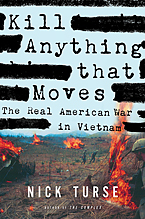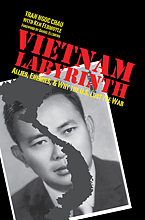 |
|||||||||||
|
ARTS OF WAR, January/February 2013 New Book Claims The War In Vietnam Was REVIEWS BY MARC LEEPSON
This review of Nick Turse’s Kill Anything That Moves: The Real American War in Vietnam (Metropolitan/Holt, 384 pp., $28) is based on a very careful reading of the book. I also am judging Turse’s work based on what I saw and heard when I was in Vietnam as a U.S. Army draftee from December 1967 to December 1968—as well as what I know about the war from reading scores of books on the subject and from talking about the war countless times with dozens of other Vietnam veterans over the last four decades. My conclusion: Turse is to be commended for compiling a detailed, well-documented account of atrocities committed by American troops against civilians in the Vietnam War. But—and this is a big “but”—Turse has failed dismally by neglecting to provide the right amount of context for his single-minded version of what he calls the “real American war” in Vietnam. Turse’s main misstep is that he only cursorily mentions the tactics of the other side—tactics that unequivocally contributed to untold numbers of civilian casualties in the Vietnam War. Secondly, in his zeal to paint all of us who served in Vietnam as complicit in what he depicts as an unending string of civilian atrocities, Turse all but ignores the positive accomplishments of the 2.8 million Americans who served in Vietnam. Do not turn to this book if you want to read about U.S. military medical teams visiting rural villages, for example, or Army or Marine programs that worked to bring sanitary conditions to remote areas of the country, or American nurses, medics, and doctors treating Vietnamese civilians and even enemy POWs in evac hospitals all over South Vietnam. Or countless acts of selfless courage under fire by American soldiers, sailors, airmen, and Marines. Also in the unbalanced vein: Turse glosses over atrocities committed by the Viet Cong and North Vietnamese Army, and never once mentions a murder, rape, or other foul deed committed by any of the sides that fought in the French Indochina War. It’s not asking too much in a book that unequivocally damns an entire American army to compare and contrast the American war in Vietnam with the war that took place there from 1945-54—a war that, with many of the same actors, was similar in many ways. You won’t read a word in this book, for example, about how the French military reacted after ambushes and other attacks by the Viet Minh. To wit: “They burned houses and killed or captured any Vietnamese unlucky enough to be found. Women and young girls were routinely raped; many suffered group rape and died or were traumatized for the rest of their lives. Some were killed as they tried to escape the horror. Some women were captured by the French, raped, and then turned over for a life of prostitution in areas so isolated and far from their homes that they had no chance to escape.” Those are the words of former Viet Minh soldier Tran Ngoc Chau in his new memoir, Vietnam Labyrinth (see review below). Chau also explains the M.O. of the ARVN during the French war: “Many [civilians] were jailed or tortured or killed; if women, they were raped. Burning of homes, even entire hamlets, and confiscation of food and livestock” also took place. A recounting of the atrocities committed by the French, the ARVN, the Viet Cong, or the North Vietnamese Army does not condone American atrocities. I bring them up here to illustrate a serious deficiency in Turse’s book—not to deny that Americans committed too many atrocities in the war. If you don’t believe there were thousands of cases of American troops running amok among the civilian population in Vietnam, Turse’s research will change your mind. For more than a decade, he scoured reams of U.S. military archival documents, read countless memoirs and other primary source materials, and interviewed Vietnam veterans and Vietnamese victims of the brutality. His book leaves little doubt that—encouraged by body-count-minded war managers and badly trained junior officers, and abetted by Gen. Westmoreland’s search-and-destroy strategy and strong feelings of antipathy for the Vietnamese—American atrocities “went on all the time, all over South Vietnam, for years and years.” But ripped out of context, this accounting presents a false picture of the Vietnam War as experienced by the overwhelming majority of those of us who took part in it—and who did not come close to murdering, raping, or committing any other kind of atrocity.
Chau was born in 1925 in Hue into a prominent Confucian-Buddhist family. A fervent nationalist, Chau joined the communist-led Viet Minh near the end of World War II to fight the French, who were trying to reclaim their Indochinese colonies (which had been overrun by the Japanese) after the war. Chau, who fought with valor and distinction against the French, became disillusioned with Ho Chi Minh and the Viet Minh in 1950. So he severed ties with the Viet Minh and allied himself with Emperor Bao Dai, who also was prime minister of the nominally independent, fledgling government in South Vietnam. Chau joined the new army of what would become South Vietnam. By 1952 he was in the field fighting the Viet Minh. He eventually became a top-level military man, working closely with the first American advisors who came to Vietnam after the French defeat in 1954. Chau even took ten months of advanced infantry training at Fort Benning in 1955 with two dozen other Vietnamese officers. He spent the next twenty years enmeshed in the fighting against the Viet Cong and North Vietnamese. Tran Ngoc Chau tells his amazing life story in Vietnam Labyrinth: Allies, Enemies, & Why the U.S. Lost the War (Texas Tech University, 480 pp., $39.95) with the help of the writer Ken Fermoyle. More than twenty years in the making, this long, detailed memoir covers the author’s long, eventful life. Chau took the drastic step of abandoning the Viet Minh when he realized that Ho Chi Minh “wanted a Communist Vietnam.” He quit the Viet Minh, Chau says, “because I wanted independence for my country but not with its traditional society and roots totally destroyed, which was the Communists’ goal. I wanted to preserve the value of our culture and my religion, to see peace and social justice for everyone, but without unnecessary class struggle.” In 1967 Chau went into politics and rose to the upper echelons of the South Vietnamese government. But he fell prey to internecine political machinations by a former close friend, Nguyen Van Thieu, and was jailed on trumped-up charges. Then, after the communist takeover in 1975, he was placed in draconian re-education camps by the new regime. Chau and his family escaped to the U.S. in 1979. His book, which contains much reconstructed dialogue, includes Chau’s thoughts on what the Americans did wrong during the Vietnam War. The list includes American arrogance; ignorance of Vietnamese history, society, and culture; and the failure to concentrate on “hearts and minds” pacification programs.
|
|||||||||||
|
|||||||||||
8719 Colesville Road, Suite 100, Silver Spring. MD 20910 | www.vva.org | contact us |
|||||||||||









